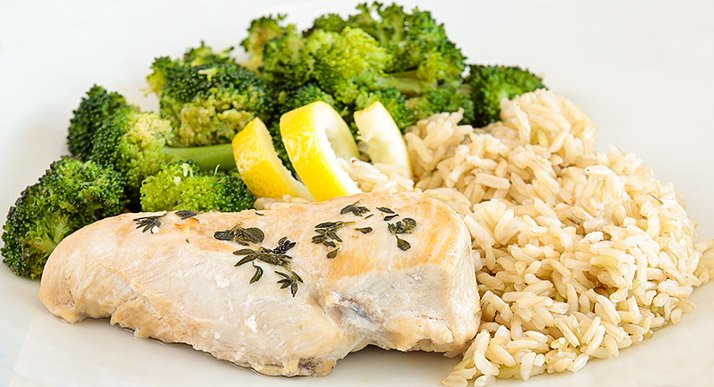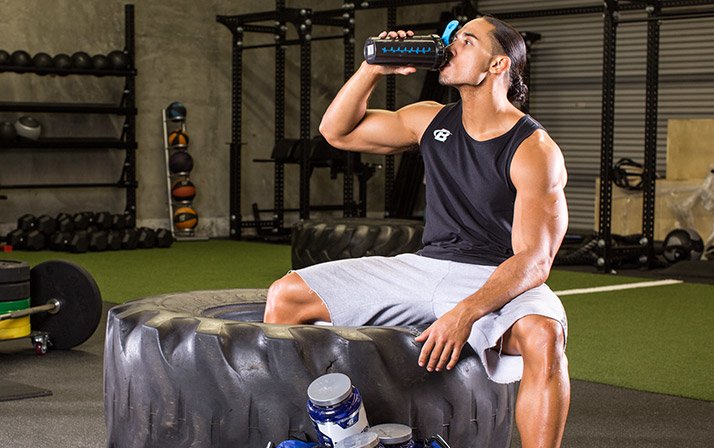
The Science Of Nutrient Timing!
The science of nutrient timing is nowhere near as exciting as beaming Mudd's women aboard your vessel, but for the athlete, it is important.
James T. Kirk and the crew of the Starship Enterprise believed that space was the "final frontier," an undiscovered territory full of strange new worlds, new life and new civilizations. So they set out to "boldly go where no man has gone before."
Following the lead of Kirk and his crew, a new crop of nutrition and exercise scientists has begun an exploration of their own, set against the backdrop of human physiology. Here on earth, nutrition and exercise scientists have suggested that the "final frontier" of the muscle-building realm is "nutrient timing." And while the science of "nutrient timing" is nowhere near as exciting as beaming Mudd's women aboard your vessel, put it to good use and your physique might just land you a few sultry females from this galaxy.
What Is Nutrient Timing?
With respect to manipulating body composition and athletic performance, traditional nutritionists have spent much of their time figuring out how much to eat and to a smaller extent, what to eat. Of course, both of these approaches have immense value. Although a myriad of factors affect energy balance (more than can be understood by a simple appraisal of how much you eat and how much you exercise; see Hungry, Hungry Hormones Part I for a more complete picture), the laws or thermodynamics are the most important determinants of weight gain and weight loss. Therefore, how much we eat is critical in altering our body composition (and indirectly, our performance).
But conventional thermodynamic approaches tell just a portion of the story. After all, few people would benefit from focusing exclusively on weight gain or weight loss. Rather, the focus should be on the composition of the gain or loss. If you're losing equal amounts of fat and muscle when in "negative energy balance" or gaining equal amounts of fat and muscle when in "positive energy balance," you're probably not taking advantage of the full spectrum of nutrition and exercise information available.
Although this might be a bit of an oversimplification of a complex topic, in some ways the thermodynamic approach of measuring calories in vs. calories out may simply maintain the body shape status quo. If you have got the right genetics, the calorie in vs. calorie out approach will probably be all you need to look good naked at any body size (bigger or smaller). But, if not, simply counting calories will probably just make you a bigger or smaller version of your former self (and if you're unhappy with that shape, you won't necessarily like it at a bigger or smaller size).
To address some of these limitations of the thermodynamic or "calorie balance" approaches, scientists recognized the value of studying the effects of food selection on body composition changes (for more on this concept, see Lean Eatin' 1 and Lean Eatin' 2). While this line of investigation is in its relative infancy, it's becoming clear that there is something to this whole food type thing.
Despite what naysayers claim, once energy balance is accounted for, some carbohydrates are better than others. Likewise, some proteins are better than others and some fats better than others.
Therefore, by choosing your food wisely, even if you're eating the same number of calories each day, you can up regulate your metabolism, shift your hormonal profile and alter the composition of your weight gain and weight loss (not to mention reap the health benefits of a better diet composition).
As you can see, the science of what to eat has added to the how-much-to-eat picture and advanced our understanding of body composition manipulation. By recognizing the laws of thermodynamics and eating accordingly we can set the stage for weight loss or weight gain. And by choosing our foods wisely, we wield the power to take control of what types of gains and losses we'll see. In some respects, the science of what to eat has given us the power to transcend some of our genetic "inclinations" (i.e. overall body shape).
While the how-much-to-eat and what-to-eat approaches offer plenty of great nutrition information, one newly-emerging area of research, "nutrient timing," has begun to demonstrate that manipulating the time dimension can further assist in taking control of our body composition and athletic performance. In this way, nutrient timing, or the science of when to eat, is becoming an important part of nutritional planning.

What's So Special About When We Eat?
To the average person who is not exercising, the principles of nutrient timing are not very important. Sure, glucose tolerance/insulin sensitivity is altered during the course of a day but these changes probably aren ot critical to determining one's dietary needs.
For these individuals, what and how much they eat is the most important thing. While nutrient timing isn't critical to the average person, its importance must not be underestimated in the athlete (including team sport athletes, endurance athletes, and weight trainers).
In the book, "Nutrient Timing" (a book I also contributed to), Drs. John Ivy and Robert Portman make a great comment about the current state of sports nutrition practice.
In this book they highlight the fact that as scientists began to learn about the nutritional needs of athletes/weightlifters (i.e. higher energy needs and the benefits of additional protein ingestion), a "bulk nutrition" concept was adopted in which athletes began to believe things like "if protein is good, then more protein must be better." (You don't know anyone like that, do you?) In other words, when many athletes find out that something is "good," they try to get lots of it. And when many athletes find out that something is "bad," they try to avoid it at all costs.
Unfortunately this is nothing more than a combination of the how-much-to-eat and what-to-eat approaches discussed above. Combine that with a naive good vs. bad approach to food and you've got a recipe for sub-optimal nutritional intake. After all, few foods are always good or always bad (well, I can think of a few?). This is certainly unfortunate for two reasons.
First, much of the current science points to the fact that if you train regularly, the body is primed for fat gain or fat loss just as it's primed for muscle gain or muscle loss during specific times of the day. Add in the wrong foods at the wrong times and you sabotage your efforts in the gym. Add the right foods and your efforts are given a giant boost.
Secondly, although some foods are not optimal during certain times of the day (i.e. sugar), some of these same foods can actually be beneficial during other times of the day (such as the post-workout period).
Throwing aside the oversimplification inherent in the bulk nutrition concept, let's now get down to the nuts and bolts of optimal nutrient timing. Since I was a consultant in the development of the book, I'm going to go ahead and take the liberty of borrowing from some of Drs. Ivy and Portman's nomenclature.
In the book, the authors refer to three critical times of the day in which nutrient timing takes on a greater importance. These times are known as the Energy Phase, The Anabolic Phase, and The Growth Phase. Since I like these distinctions, I'll use them here. However, I'll add another phase that I call, somewhat in jest, The Rest of The Day Phase.

Nutrient Timing - The Energy Phase
The Energy Phase is called this because this phase occurs during the workout when energy demands are highest. As you probably know, the energy used by skeletal muscle is ATP. This ATP is formed and resynthesized by macronutrients from the diet so carbs, proteins, and fats contribute indirectly to the energy of muscle contraction.
Therefore, the high rates of energy demand during exercise are met by ingested nutrients and/or stored nutrients (the ratio depends on your feeding schedule). This breakdown of nutrients, while completely necessary, is, by definition, catabolic. As such, the workout period, as I've addressed in the past (see Precision Nutrition - next week), is marked by a number of anabolic and catabolic effects.
Anabolic Effects Of Acute Exercise
- Increased Skeletal Muscle Blood Flow
- Increased Anabolic Hormone Release
- (GH, Testosterone, IGF-1)
- Decreased Insulin Concentrations
Catabolic Effects Of Acute Exercise
- Glycogen Depletion
- Decreased Net Protein Balance
- Increased Cortisol Concentrations
- Decreased Insulin Concentrations
- Acute Phase Response Breakdown
- Increased Metabolic Rate
- Dehydration (Endurance or Intermittent Exercise in Heat)
While these phenomena are nothing new and have been shown to occur during most types of exercise/training, what is new is the idea that targeted nutritional intake can actually shift the anabolic/catabolic balance during exercise, enhancing some of the anabolic effects while minimizing some of the catabolic effects (1; 4; 10; 11; 17).
To give you an example, a protein/carbohydrate supplement (like Metabolic Diet Power Drink) ingested immediately prior to exercise (or sipped during exercise) can actually increase skeletal muscle blood flow. Since this drink not only enhances blood flow but stocks that blood up with amino acids and glucose, the protein balance of the muscle will be shifted toward the positive and glycogen depletion will be significantly reduced.
In addition, those amino acids and glucose units, independent of their effects on muscle protein and glycogen status, can also lead to a decrease in cortisol concentrations and improve the overall immune response (part of the acute phase response listed above and described in detail in the Precision Nutrition article).
Of course, if the aforementioned supplement is in a liquid form and is sipped during the exercise bout (as recommended), dehydration, a potent performance killer in both strength and endurance athletes, can be staved off as well. That's not too shabby for a little ol' protein/carbohydrate drink, eh?

The When, What and How Much of the Energy Phase
When examining the science of nutrient timing in detail, it becomes clear that one of the key "when to eat" times of the day is during the Energy Phase or during the workout. Of course, in focusing on when to eat, I'm in no way suggesting we should neglect considering what and how much to eat. In fact, they're probably your next two questions so let's get to them right away.
As indicated above, during the Energy Phase it's important to ingest some protein and carbohydrate. In my experience the easiest way to do this is to drink an easily digested liquid carbohydrate and protein drink. This drink should probably consist of a well-diluted (a 6-10% solution - meaning 60-100g of powder for every 1L of water) combination of glucose, maltodextrin, and whey protein/hydrolyzed whey protein.
Dilution is important, especially if you are an endurance athlete or if you're training in a hot environment. If you don't dilute your drink appropriately, you may not replenish your body's water stores at an optimal rate (9; 12).
Now that we know when to eat and what to eat, let's figure out how much. Unfortunately this isn't as easy to answer. How much to eat really has a lot to do with how much energy you're expending during the exercise bout, how much you're eating the rest of the day, whether your primary interest is gaining muscle mass or losing fat mass, and a number of other factors.
For a simple answer, however, I suggest starting out by sipping 0.8g of carbohydrate/kg and 0.4g of protein/kg diluted in somewhere around 1L of water (5; 17-20). For you 220lb guys, that means 80g of carbohydrate and 40g of protein during training. This, of course, is the nutrient make-up of Surge.
Endurance Athlete Energy Phase (During Exercise)
Meal Calculator
Nutrient Timing - The Anabolic Phase
The Anabolic Phase occurs immediately after the workout and lasts about an hour or two. This phase is titled "anabolic" because it's during this time that the muscle cells are primed for muscle building. Interestingly, although the cells are primed for muscle building, in the absence of a good nutritional strategy, this phase can remain catabolic.
Without adequate nutrition, the period immediately after strength and endurance training is marked by a net muscle catabolism; that's right, after exercise muscles continue to break down. Now, if you're asking yourself how this can be, you're asking the right question. After all, training (especially weight training) makes you bigger, not smaller. And even if you're an endurance athlete, your muscles don't exactly break down either. So how can exercise be so catabolic?
Well, for starters, as I've written before, while the few hours after exercise induce a net catabolic state (although protein synthesis does increase after exercise, so does breakdown), it's later in the recovery cycle that the body begins to shift toward anabolism (8; 14). So we typically break down for some time after the workout and then start to build back up later (whether that "build up" is in muscle size or in muscle quality).
However, with this said, there are new data showing that with the right nutritional intervention (protein and carbohydrate supplementation), we can actually repair and improve muscle size or quality during and immediately after exercise (16; 17). And the best part is that if we do the nutrition thing right, not only do we start repairing muscle during and after exercise, we continue to alter muscle size and/or quality later on as well (16).
For more on what happens during the postexercise period, check out my articles Solving the Post-Workout Puzzle 1 and Solving the Post Workout Puzzle 2.

The When, What and How Much of the Anabolic Phase
From now on, when planning your nutritional intake, you'd better consider both the Energy and Anabolic phases as two of the key "whens" of nutrient timing. Therefore, to maximize your muscle gain and recovery, you'll be feeding both during and immediately after exercise. Again we come to what and how much.
As indicated above, during the Anabolic Phase it's important to ingest some protein and carbohydrate. Just like with the Energy Phase, in my experience the easiest way to do this is to drink an easily digested liquid carbohydrate and protein drink.
This drink should probably consist of a well-diluted (a 6-10% solution - meaning 60-100g of powder for every 1L of water) combination of glucose, maltodextrin and whey protein/hydrolyzed whey protein. While dilution, in this case, isn't as important for rehydration because you've stopped exercising and presumably, sweating, you're now diluting to prevent gastrointestinal distress. I won't go to far into detail here - just take my word for it. You must dilute.
Now that we know when to eat and what to eat, let's figure out how much. Just like with the Energy Phase, how much to eat really has a lot to do with how much energy you expend during the exercise bout, how much you eat the rest of the day, whether your primary interest is gaining muscle mass or losing fat mass, and a number of other factors. However, just like with the Energy Phase, a simple suggestion is to start out by sipping another serving of 0.8g of carbohydrate/kg and 0.4g of protein/kg diluted in somewhere around 1L of water (5; 17-20).
If you add up the basic suggestions from the Energy Phase and the Anabolic Phase, you'll find that I've recommended about 1.6g of carbohydrate/kg and 0.8g of protein/kg in total. For a 220lb guy, that's a total of 160g carbohydrate and 80g of protein during and immediately after training. Based on your preconceived notions of what constitutes "a lot" of carbs, this may seem like a lot or not much at all.
Regardless, it's important to understand that during and after training, insulin sensitivity and glucose tolerance is good (2; 3; 13; 15; 21). Even if you've self-diagnosed poor carbohydrate tolerance (which too many people do unnecessarily) during and after the postexercise period, your carbohydrate tolerance will be much better.
Endurance Athlete Post-Workout Meals Calculator
Meal Calculator
And if you consider that most carbohydrate ingested during and immediately after exercise will either be oxidized for fuel or sent to the muscle and liver for glycogen resynthesis and that even in the presence of increased insulin concentrations, the postexercise period is marked by a dramatic increase in fat metabolism (6; 7), it should be clear that even a whopping carbohydrate and protein drink will not directly lead to fat gain. Just be sure to account for this increase in carbohydrate intake by decreasing your carbohydrate intake during other times of the day when carbohydrate resynthesis isn't so efficient and booming insulin isn't so benign.
From this discussion it should be clear that, using the principles of nutrient timing, one can load up on carbs during and after the workout while reducing them for the remainder of the day.
In using this strategy, carbs are fed when they'll best be converted into muscle glycogen and when they'll best stimulate muscle growth and/or repair. If muscle gain is your goal, you'll get more muscle per gram of carbohydrate ingested.
If fat loss is your goal, you'll get more muscle glycogen and a pronounced muscle sparing effect with fewer daily carbs ingested. And if athletic performance/recovery is your goal, your recovery will improve dramatically.
What Are Your Goals?
So before we move on, it's important to understand that the 960 kcal I recommended (for 220-pound men) would be better utilized during and after the workout than during any other time of the day and herein lies the gist of nutrient timing. Nutrients ingested during the Energy and Anabolic Phases can better contribute to muscle gain, repair and recovery when compared to the same nutrients ingested during other times of the day.
Now that I've covered what to eat during the Energy and Anabolic Phases, I'll be back next week with some recommendations for what to eat during the final two phases of the nutrient timing cycle.
